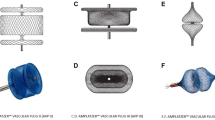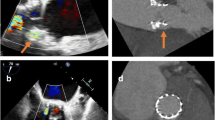Abstract
Percutaneous paravalvular leak closure represents a small but important niche in structural interventions in the current era of interventional cardiology. It is estimated that paravalvular regurgitation affects 5–17 % of all surgically implanted prosthetic heart valves (which equates to 500 to 10,200 cases annually). Patients may present with clinical signs and evidence of heart failure, hemolysis or both. Due to the increased morbidity and mortality, reoperation is often best avoided, especially if the underlying perivalvular tissue is friable or heavily calcified. Perimitral defects are usually approached in an antegrade approach via a transeptal puncture; periaortic defects usually in a retrograde approach. Depending on the number, size and shape of the defect(s) - as determined by 2D and 3D echocardiography - one or multiple closure devices are deployed using various wiring and anchor techniques. This brief review provides a summary of the currently applied paravalvular leak closure techniques.







Similar content being viewed by others
References
Papers of particular interest, published recently, have been highlighted as: • Of importance •• Of major importance
Hammermeister K, Sethi GK, Henderson WG, Grover FL, Oprian C, Rahimtoola SH. Outcomes 15 years after valve replacement with a mechanical versus a bioprosthetic valve: final report of the Veterans Affairs randomized trial. J Am Coll Cardiol. 2000;36:1152–8.
Davila-Roman VG, Waggoner AD, Kennard ED, et al. Prevalence and severity of paravalvular regurgitation in the Artificial Valve Endocarditis Reduction Trial (AVERT) echocardiography study. J Am Coll Cardiol. 2004;44:1467–72.
Kort HW, Sharkey AM, Balzer DT. Novel use of the Amplatzer duct occluder to close perivalvar leak involving a prosthetic mitral valve. Catheter Cardiovasc Interv. 2004;61:548–51.
Moore JD, Lashus AG, Prieto LR, Drummond-Webb J, Latson LA. Transcatheter coil occlusion of perivalvular mitral leaks associated with severe hemolysis. Catheter Cardiovasc Interv. 2000;49:64–7.
Moscucci M, Deeb GM, Bach D, Eagle KA, Williams DM. Coil embolization of a periprosthetic mitral valve leak associated with severe hemolytic anemia. Circulation. 2001;104:E85–6.
Hourihan M, Perry SB, Mandell VS, et al. Transcatheter umbrella closure of valvular and paravalvular leaks. J Am Coll Cardiol. 1992;20:1371–7.
• Sorajja P, Cabalka AK, Hagler DJ, Rihal CS. Percutaneous repair of paravalvular prosthetic regurgitation: acute and 30-day outcomes in 115 patients. Circ Cardiovasc Interv. 2011;4:314–21. This was the first paper reporting short term outcomes after paravalvular leak closure in the largest reported patient population.
•• Sorajja P, Cabalka AK, Hagler DJ, Rihal CS. Long-term follow-up of percutaneous repair of paravalvular prosthetic regurgitation. J Am Coll Cardiol. 2011;58:2218–24. This is, thus far, the only paper in the literature reporting long-term outcomes of paravalvular leak closure in a relatively large patient population.
• Ruiz CE, Jelnin V, Kronzon I, et al. Clinical outcomes in patients undergoing percutaneous closure of periprosthetic paravalvular leaks. J Am Coll Cardiol. 2011;58:2210–7. This paper reports outcomes of the second largest paraleak population in the current literature.
Bonow RO, Carabello BA, Chatterjee K, et al. 2008 focused update incorporated into the ACC/AHA 2006 guidelines for the management of patients with valvular heart disease: a report of the American College of Cardiology/American Heart Association Task Force on Practice Guidelines (Writing Committee to revise the 1998 guidelines for the management of patients with valvular heart disease). Endorsed by the Society of Cardiovascular Anesthesiologists, Society for Cardiovascular Angiography and Interventions, and Society of Thoracic Surgeons. J Am Coll Cardiol. 2008;52:e1–e142.
Vahanian A, Alfieri O, Andreotti F, et al. Guidelines on the management of valvular heart disease (version 2012): the Joint Task Force on the Management of Valvular Heart Disease of the European Society of Cardiology (ESC) and the European Association for Cardio-Thoracic Surgery (EACTS). Eur J Cardiothorac Surg. 2012;42:S1–S44.
Jelnin V, Dudiy Y, Einhorn BN, Kronzon I, Cohen HA, Ruiz CE. Clinical experience with percutaneous left ventricular transapical access for interventions in structural heart defects a safe access and secure exit. JACC Cardiovasc Interv. 2011;4:868–74.
Morgan GJ, Waragai T, Eastaugh L, Chaturvedi RC, Lee KJ, Benson L. The fellows stitch: large caliber venous hemostasis in pediatric practice. Catheter Cardiovasc Interv. 2012;80:79–82.
Compliance with Ethics Guidelines
Conflict of Interest
Mario Gössl declares that he has no conflict of interest.
Charanjit S. Rihal declares that he has no conflict of interest.
Human and Animal Rights and Informed Consent
This article does not contain any studies with human or animal subjects performed by any of the authors.
Author information
Authors and Affiliations
Corresponding author
Additional information
This article is part of the Topical Collection on Interventional Cardiology
Rights and permissions
About this article
Cite this article
Gössl, M., Rihal, C.S. Percutaneous Treatment of Aortic and Mitral Valve Paravalvular Regurgitation. Curr Cardiol Rep 15, 388 (2013). https://doi.org/10.1007/s11886-013-0388-9
Published:
DOI: https://doi.org/10.1007/s11886-013-0388-9




